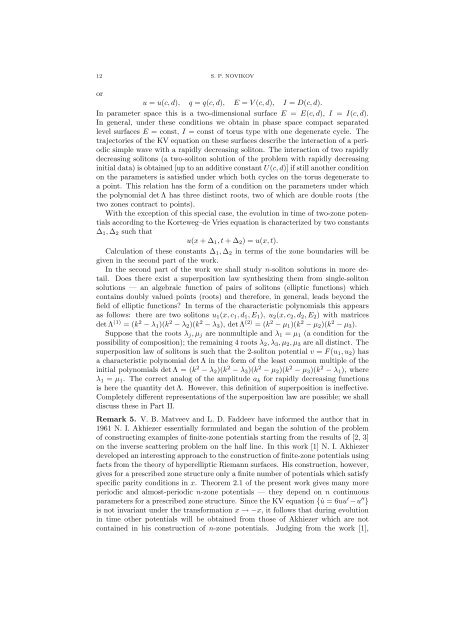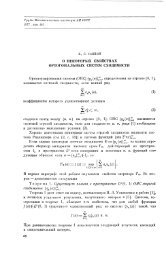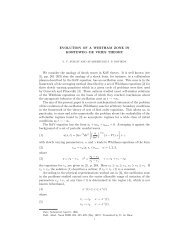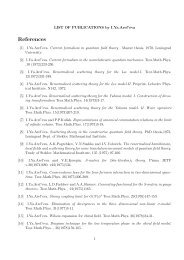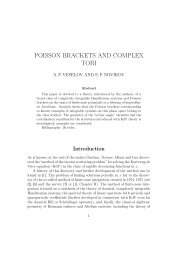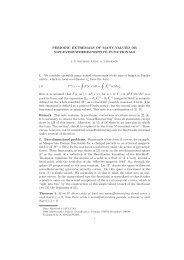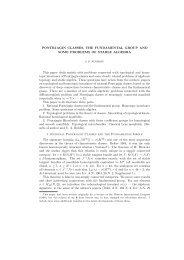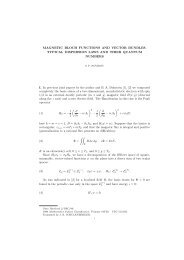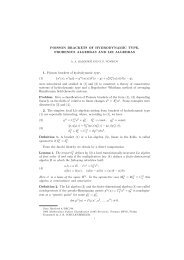A periodic problem for the Korteweg-de Vries equations, I.
A periodic problem for the Korteweg-de Vries equations, I.
A periodic problem for the Korteweg-de Vries equations, I.
Create successful ePaper yourself
Turn your PDF publications into a flip-book with our unique Google optimized e-Paper software.
12 S. P. NOVIKOVoru = u(c, d), q = q(c, d), E = V (c, d), I = D(c, d).In parameter space this is a two-dimensional surface E = E(c, d), I = I(c, d).In general, un<strong>de</strong>r <strong>the</strong>se conditions we obtain in phase space compact separatedlevel surfaces E = const, I = const of torus type with one <strong>de</strong>generate cycle. Thetrajectories of <strong>the</strong> KV equation on <strong>the</strong>se surfaces <strong>de</strong>scribe <strong>the</strong> interaction of a <strong>periodic</strong>simple wave with a rapidly <strong>de</strong>creasing soliton. The interaction of two rapidly<strong>de</strong>creasing solitons (a two-soliton solution of <strong>the</strong> <strong>problem</strong> with rapidly <strong>de</strong>creasinginitial data) is obtained [up to an additive constant U(c, d)] if still ano<strong>the</strong>r conditionon <strong>the</strong> parameters is satisfied un<strong>de</strong>r which both cycles on <strong>the</strong> torus <strong>de</strong>generate toa point. This relation has <strong>the</strong> <strong>for</strong>m of a condition on <strong>the</strong> parameters un<strong>de</strong>r which<strong>the</strong> polynomial <strong>de</strong>t Λ has three distinct roots, two of which are double roots (<strong>the</strong>two zones contract to points).With <strong>the</strong> exception of this special case, <strong>the</strong> evolution in time of two-zone potentialsaccording to <strong>the</strong> <strong>Korteweg</strong>–<strong>de</strong> <strong>Vries</strong> equation is characterized by two constants∆ 1 , ∆ 2 such thatu(x + ∆ 1 , t + ∆ 2 ) = u(x, t).Calculation of <strong>the</strong>se constants ∆ 1 , ∆ 2 in terms of <strong>the</strong> zone boundaries will begiven in <strong>the</strong> second part of <strong>the</strong> work.In <strong>the</strong> second part of <strong>the</strong> work we shall study n-soliton solutions in more <strong>de</strong>tail.Does <strong>the</strong>re exist a superposition law syn<strong>the</strong>sizing <strong>the</strong>m from single-solitonsolutions — an algebraic function of pairs of solitons (elliptic functions) whichcontains doubly valued points (roots) and <strong>the</strong>re<strong>for</strong>e, in general, leads beyond <strong>the</strong>field of elliptic functions? In terms of <strong>the</strong> characteristic polynomials this appearsas follows: <strong>the</strong>re are two solitons u 1 (x, c 1 , d 1 , E 1 ), u 2 (x, c 2 , d 2 , E 2 ) with matrices<strong>de</strong>t Λ (1) = (k 2 − λ 1 )(k 2 − λ 2 )(k 2 − λ 3 ), <strong>de</strong>t Λ (2) = (k 2 − µ 1 )(k 2 − µ 2 )(k 2 − µ 3 ).Suppose that <strong>the</strong> roots λ j , µ j are nonmultiple and λ 1 = µ 1 (a condition <strong>for</strong> <strong>the</strong>possibility of composition); <strong>the</strong> remaining 4 roots λ 2 , λ 3 , µ 2 , µ 3 are all distinct. Thesuperposition law of solitons is such that <strong>the</strong> 2-soliton potential v = F (u 1 , u 2 ) hasa characteristic polynomial <strong>de</strong>t Λ in <strong>the</strong> <strong>for</strong>m of <strong>the</strong> least common multiple of <strong>the</strong>initial polynomials <strong>de</strong>t Λ = (k 2 − λ 2 )(k 2 − λ 3 )(k 2 − µ 2 )(k 2 − µ 3 )(k 2 − λ 1 ), whereλ 1 = µ 1 . The correct analog of <strong>the</strong> amplitu<strong>de</strong> a k <strong>for</strong> rapidly <strong>de</strong>creasing functionsis here <strong>the</strong> quantity <strong>de</strong>t Λ. However, this <strong>de</strong>finition of superposition is ineffective.Completely different representations of <strong>the</strong> superposition law are possible; we shalldiscuss <strong>the</strong>se in Part II.Remark 5. V. B. Matveev and L. D. Fad<strong>de</strong>ev have in<strong>for</strong>med <strong>the</strong> author that in1961 N. I. Akhiezer essentially <strong>for</strong>mulated and began <strong>the</strong> solution of <strong>the</strong> <strong>problem</strong>of constructing examples of finite-zone potentials starting from <strong>the</strong> results of [2, 3]on <strong>the</strong> inverse scattering <strong>problem</strong> on <strong>the</strong> half line. In this work [1] N. I. Akhiezer<strong>de</strong>veloped an interesting approach to <strong>the</strong> construction of finite-zone potentials usingfacts from <strong>the</strong> <strong>the</strong>ory of hyperelliptic Riemann surfaces. His construction, however,gives <strong>for</strong> a prescribed zone structure only a finite number of potentials which satisfyspecific parity conditions in x. Theorem 2.1 of <strong>the</strong> present work gives many more<strong>periodic</strong> and almost-<strong>periodic</strong> n-zone potentials — <strong>the</strong>y <strong>de</strong>pend on n continuousparameters <strong>for</strong> a prescribed zone structure. Since <strong>the</strong> KV equation { ˙u = 6uu ′ −u ′′ }is not invariant un<strong>de</strong>r <strong>the</strong> trans<strong>for</strong>mation x → −x, it follows that during evolutionin time o<strong>the</strong>r potentials will be obtained from those of Akhiezer which are notcontained in his construction of n-zone potentials. Judging from <strong>the</strong> work [1],


